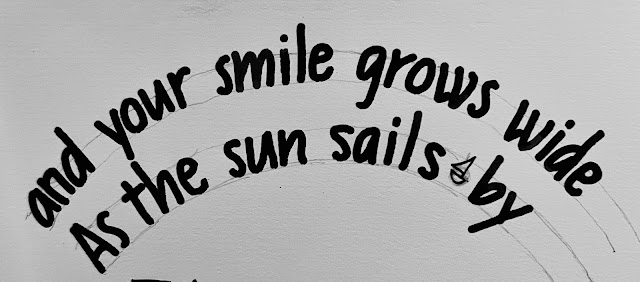 |
| Letters in Martha's Studio by Bill Slavin |
Opening up the garbage can filled with rain water, I took a leap back at what I saw: four, 3-inch slugs slowly slithering their way up the sides of the can. OOO, boy, just a reminder of the Uglies that sprout to our attention this time of the year. Spiders are more prominent, mice scurry along a wall, mushrooms pop up one day and disappear the next, the howl of coyotes wakes us up in the night, and we think of witches and other creepy things as we draw closer to Halloween and Day of the Dead. Spookiness abounds.
Where in the world did these slugs come from? I know that debris collects in the open barrel during the rainy season, but I have never seen slugs creep out of the water before. They are hermaphrodites with both female and male components and lay eggs in moist locations. They are part of the beneficial beings who provide food for small animals and birds. I know all this, but I am still startled and repulsed by them. Especially when they grow over four inches in length and are bright yellow. They also eat my plants just like snails do.
I picked up a piece of decaying wood recently and was surprised by a bright red-orange salamander under the wood. Again my primitive brain kicked in and I jumped back from the sight. Salamanders, like slugs, have shiny, moist bodies and are good at eating small insects and even snails. They are sometimes called mud puppies or hellbenders. The origin of the name hellbenders is murky. It maybe because thought of them because of their appearance as trying to get back to hell.Again, salamanders are a beneficial part of the garden. So, I put the wood back as quickly as I could.
What is it about autumn, my favorite time of the year, that brings out these chills and frights? Is it our way to ward off the long nights of winter?
.jpeg) |
| A challenge using the alphabets designed by Corita Kent |
Crows and ravens, wolves, spiders, and owls all have been victims of our frightful stories. We've given them oversized roles in scaring us when mostly they would just like to be left alone. Even cats that now proliferate on cute social media videos have been hunted to almost extinction in some centuries because of their supposed association with witches. Don't we have enough scary people in this world without foisting unfair characterizations on animals? Give these creatures who live among us a break.
 |
| Poe's Raven, another being who gets a bad rep. |
******************
Autumn is a good season to give back to the Indigenous people who came before us and who continue to offer insight into living: Check out the Indigenous First Gift Shop here:
Or read Indigenous scientist, Robin Wall Kimmerer's Braiding Sweetgrass
If you live in California, you might consider contributing to the Shuumi Land Tax:


.jpeg)
.jpeg)
.jpeg)















.jpeg)

.jpeg)
